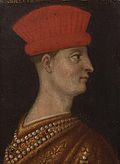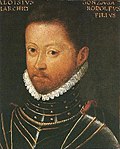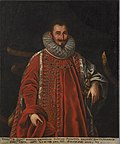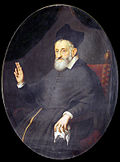Top Qs
Timeline
Chat
Perspective
House of Gonzaga
Italian royal family that ruled parts of Northern Italy From Wikipedia, the free encyclopedia
Remove ads
The House of Gonzaga (US: /ɡənˈzɑːɡə, ɡɒn-, -ˈzæɡ-/,[2] Italian: [ɡonˈdzaːɡa]) is an Italian princely family that ruled Mantua in Lombardy, northern Italy from 1328 to 1708 (first as a captaincy-general, then margraviate, and finally duchy). They also ruled Monferrato in Piedmont and Nevers in France, as well as many other lesser fiefs throughout Europe. The family includes a saint, twelve cardinals and fourteen bishops. Two Gonzaga descendants became empresses of the Holy Roman Empire (Eleonora Gonzaga and Eleonora Gonzaga-Nevers), and one became Queen of Poland and Grand Duchess of Lithuania in the Polish–Lithuanian Commonwealth (Marie Louise Gonzaga).
Remove ads
History
Summarize
Perspective
The first members of the family of historical importance are known to have collaborated with the Guelph faction alongside the monks of the Polirone Abbey.[3] Starting from the 12th century they became a dominant family in Mantua, growing in wealth when their allies, the Bonacolsi, defeated the traditional familiar enemy, the Casalodi. In 1328, however, Ludovico I Gonzaga overthrew the Bonacolsi lordship over the city with the help of the Scaliger, and entered the Ghibelline party as capitano del popolo ("people's captain") of Mantua and imperial vicar of Emperor Louis IV.[4]
Ludovico was succeeded by Guido (1360–1369) and Ludovico II (1369–1382), while Feltrino, lord of Reggio until 1371, formed the cadet branch of the Gonzaga of Novellara, whose state existed until 1728. Francesco I (1382–1407) abandoned the traditional alliance with the Visconti of Milan, in order to align their rising power with the Republic of Venice.
- Ludovico III Gonzaga, Marquis of Mantua and Barbara of Brandenburg with their children, fresco by Andrea Mantegna at San Giorgio Castle, Mantua, around 1470.
- Arms of the Gonzaga-Nevers branch that inherited the Duchy of Mantua from the extinct senior line and ruled it from 1627 to 1708, when that branch died out in the male line.
In 1433, Gianfrancesco I assumed the title of Marquis of Mantua with the recognition of Emperor Sigismund, while obtaining recognition from the local nobility through the marriage of his daughter Margherita to Leonello d'Este, Marquis of Ferrara in 1435. In 1530 Federico II (1500–1540) received the title of Duke of Mantua. Also the two brothers of Federico II are historical characters of a certain importance: Ercole Gonzaga became a cardinal, presided over the Council of Trent and was almost elected Pope; Ferrante was a faithful ally of the Emperor Charles V who covered him with honors and positions, Ferrante was also the progenitor of the cadet branch of the Gonzaga of Guastalla. In 1531, the family acquired the Marquisate of Montferrat through marriage. Through maternal ancestors, the Gonzagas inherited also the Imperial Byzantine ancestry of the Paleologus, an earlier ruling family of Montferrat.
A cadet branch of the Mantua Gonzagas became dukes of Nevers and Rethel in France when Luigi (Louis) Gonzaga, a younger son of Federico II Gonzaga, Duke of Mantua, and Margherita Paleologa, married the heiress. The Gonzaga-Nevers later came to rule Mantua again when Louis's son Charles (Carlo) inherited Mantua and Montferrat, triggering the War of the Mantuan Succession.
Another cadet branch were first sovereign counts, later dukes of Guastalla. They descended from Ferrante, a younger son of Duke Francesco II of Mantua (1484–1519). Ferrante's grandson, Ferrante II, also played a role in the War of the Mantuan Succession. A further cadet branch was that of Sabbioneta, founded by Gianfrancesco, son of Ludovico III.
Marie Louise Gonzaga, daughter of Prince Charles Gonzaga-Nevers, was a queen consort of Poland and grand duchess consort of Lithuania from 1645 to her death in 1667.
Two daughters of the house, both named Eleanor Gonzaga, became Holy Roman Empresses, by marrying emperors Ferdinand II of Germany and Ferdinand III, Holy Roman Emperor, respectively. From the latter Empress Eleonora, the current heirs of the Gonzaga descend.
Saint Aloysius Gonzaga was a member of a junior branch of this family.
The House of Gonzaga is the inspiration for the play-within-the-play in Shakespeare's Hamlet. In Act 3 scene 2, they act out a play called The Murder of Gonzago (or The Mousetrap).
Gonzaga rule continued in Mantua until 1708 and in Guastalla until 1746. Both ruling lines going extinct until passing on to a minor Gonzaga-Vescovato branch, which is the only remaining existing branch.
Patronage of the arts
The House of Gonzaga was an important patron of the arts. This began when Gianfrancesco Gonzaga funded a school led by Vittorino da Feltre where music and art were core subjects along with mathematics, history, Greek and Latin, religion, and philosophy. The music theorist and composer Franchinus Gaffurius was trained at this school. Isabella d'Este, wife of Francesco II Gonzaga, Marquis of Mantua, used her influence to financially support native composers at court (such as Bartolomeo Tromboncino and Marchetto Cara) which contributed to popularizing the frottola. Cardinal Ercole Gonzaga founded an ecclesiastical chapel which employed musicians and further advance the musical live of the region through sacred music composition and performance.[5]
Guglielmo Gonzaga, Duke of Mantua, himself a gifted composer, founded the Basilica palatina di Santa Barbara (construction began 1562) which became a cultural center for sacred art and music. He also brought several notable composers to the Mantua court, including Alessandro Striggio, Giovanni Giacomo Gastoldi, Giaches de Wert, Benedetto Pallavicino and Claudio Monteverdi. Through Monteverdi, the court witnessed some of the first operas ever staged, including L'Orfeo (1607) and L'Arianna (1608). Marco da Gagliano's La Dafne was staged in 1608.[5]
The Gonzaga House also sponsored theatre. The Mantua court staged Giovanni Battista Guarini's plays Il pastor fido and L'idropica. These plays included incidental music by several different composers, including Monteverdi, Gastoldi, Gagliano, Paolo Birt, and Salamone Rossi. Ferdinando Gonzaga, Duke of Mantua also supported the arts, but financial problems for the court led to a decline in support during his reign.[5]
Ferdinando Carlo Gonzaga, Duke of Mantua and Montferrat employed Antonio Caldara as maestro di cappella from 1701-1707.[5]
Remove ads
Rulers of the House of Gonzaga
Summarize
Perspective
House of Gonzaga
Partitions of Mantua under Gonzaga rule
| Lordship of Bagnolo (1399–1509) | ||||||||||
| Lordship of Mantua (1328–1433) Raised to: Marquisate of Mantua (1433–1530) |
Marquisate of Ostiano (1st creation) (1444–1466) |
Lordship of Luzzara (1444–1561) (brief reunion with Mantua 1460–1478) Raised to: Marquisate of Luzzara (1561–1794) | ||||||||
| Raised to: Duchy of Mantua (1530–1708) (with Montferrat since 1536) |
County of Sabbioneta (1478–1577) |
Marquisate of Ostiano (2nd creation) (1478–1495) | ||||||||
| Lordship of Bozzolo (1st creation) (1496–1529[6]) |
Raised to: Duchy of Sabbioneta (1577–1637) |
Lordship of Castiglione (1494–1593) Raised to: Marquisate of Castiglione (1593–1707) | ||||||||
| Lordship of Novellara (1360–1501) Raised to: County of Novellara (1501–1737) |
Lordship of Vescovato (1519–1559) Raised to: Marquisate of Vescovato (1559–1796) |
|||||||||
| Lordship of Bozzolo (2nd creation) (1591–1668) |
Marquisate of Ostiano (3rd creation) (1591–1703) |
|||||||||
| Annexed to the Carafa and Guzmán families (1637–1689) Annexed to Spain | ||||||||||
| County of Guastalla (1539–1621) (purchased from the Torelli family) | ||||||||||
| Mantua annexed to Austria; Montferrat annexed to Savoy |
Annexed to Austria (1703–08) |
Annexed to Austria | ||||||||
| Raised to: Duchy of Guastalla (1621–1746) |
Annexed to Austria | |||||||||
| Annexed to the Duchy of Modena | ||||||||||
| Annexed to the Duchy of Parma | ||||||||||
| Annexed to Savoy | ||||||||||
Remove ads
Family tree
Summarize
Perspective
The branches of the Gonzaga family, showing marquises and (subsequently) dukes of Mantua in bold, dukes of Nevers and Rethel in italics and the Guastalla line to the right.
| Gianfrancesco Marquis of Mantua 1407–1444 | |||||||||||||||||||||||||||||||||||||||||||||||||||||||||
| Ludovico III Marquis of Mantua 1444–1478 | |||||||||||||||||||||||||||||||||||||||||||||||||||||||||
| Federico I Marquis of Mantua 1478–1484 | |||||||||||||||||||||||||||||||||||||||||||||||||||||||||
| Francesco II Marquis of Mantua (1484–1519) | |||||||||||||||||||||||||||||||||||||||||||||||||||||||||
| Margaret Paleologa Marquises of Montferrat | Federico II Marq. (1519–30), Duke (1530–40) | Ercole Bishop (1521) Cardinal (1527) | Ferrante I Count of Guastalla (1539–1557) | ||||||||||||||||||||||||||||||||||||||||||||||||||||||
| Francesco III (1540–1550) | Guglielmo I (Guglielmo X in Montferrat) (1550–1587) | Louis of Nevers (1581–1595) | Cesare I Count of Guastalla (1557–1575) | ||||||||||||||||||||||||||||||||||||||||||||||||||||||
| Vincenzo I (1587–1612) | Charles III of Nevers a.k.a. Carlo I of Mantua (1627–1637) | Ferrante II 1st. Duke of Guastalla (1575–1630) | |||||||||||||||||||||||||||||||||||||||||||||||||||||||
| Francesco IV (1612) | Ferdinando I (1612–26) | Vincenzo II (1626–27) | Charles of Nevers (1609–1631) m. Maria of Mantua | Cesare II Duke of Guastalla (1630–1632) | Andrea Count of San Paolo (d.1686) | ||||||||||||||||||||||||||||||||||||||||||||||||||||
| Maria of Mantua (1609–1660), m. Charles of Nevers | Carlo II (1637–1665) | Ferrante III Duke of Guastalla (1632–1678) | |||||||||||||||||||||||||||||||||||||||||||||||||||||||
| Ferdinando Carlo (1665–1708) | Anna Isabella (1678–1692) | Maria Vittoria (1659–1707) | Vincenzo Duke of Guastalla (1692–1714) | ||||||||||||||||||||||||||||||||||||||||||||||||||||||
| Eleonora Luisa (1686–1741) m. Francesco de' Medici | Antonio Ferrante Duke of Guastalla (1714–1729) | Giuseppe Duke of Guastalla (1729–1746) | |||||||||||||||||||||||||||||||||||||||||||||||||||||||
Saint Aloysius Gonzaga
- Aloysius Gonzaga, SJ 1568–1591, canonized by the Catholic Church in 1726
Roman Catholic cardinals
- Francesco Gonzaga (1444–1483)
- Sigismondo Gonzaga (1469–1525)
- Pirro Gonzaga (1490–1529)
- Ercole Gonzaga (1505–63)
- Francesco Gonzaga (1538–66)
- Federico Gonzaga (1540–65)
- Giovanni Vincenzo Gonzaga (1540–91)
- Scipione Gonzaga (1542–93)
- Francesco Gonzaga (1546–1620)
- Ferdinando Gonzaga (1587–1626), became Duke of Mantua, as Ferdinando I, in 1612
- Vincenzo Gonzaga (1594–1627), became Duke of Mantua, as Vincenzo II, in 1626
Remove ads
See also
- Duchy of Mantua, a list of House of Gonzaga rulers
- Duchy of Guastalla
- Duchy of Sabbioneta
- County of Novellara and Bagnolo
Bibliography
- Brinton, Selwyn (1927). The Gonzaga. Lords of Mantua. London: Methuen.
References
External links
Wikiwand - on
Seamless Wikipedia browsing. On steroids.
Remove ads































































